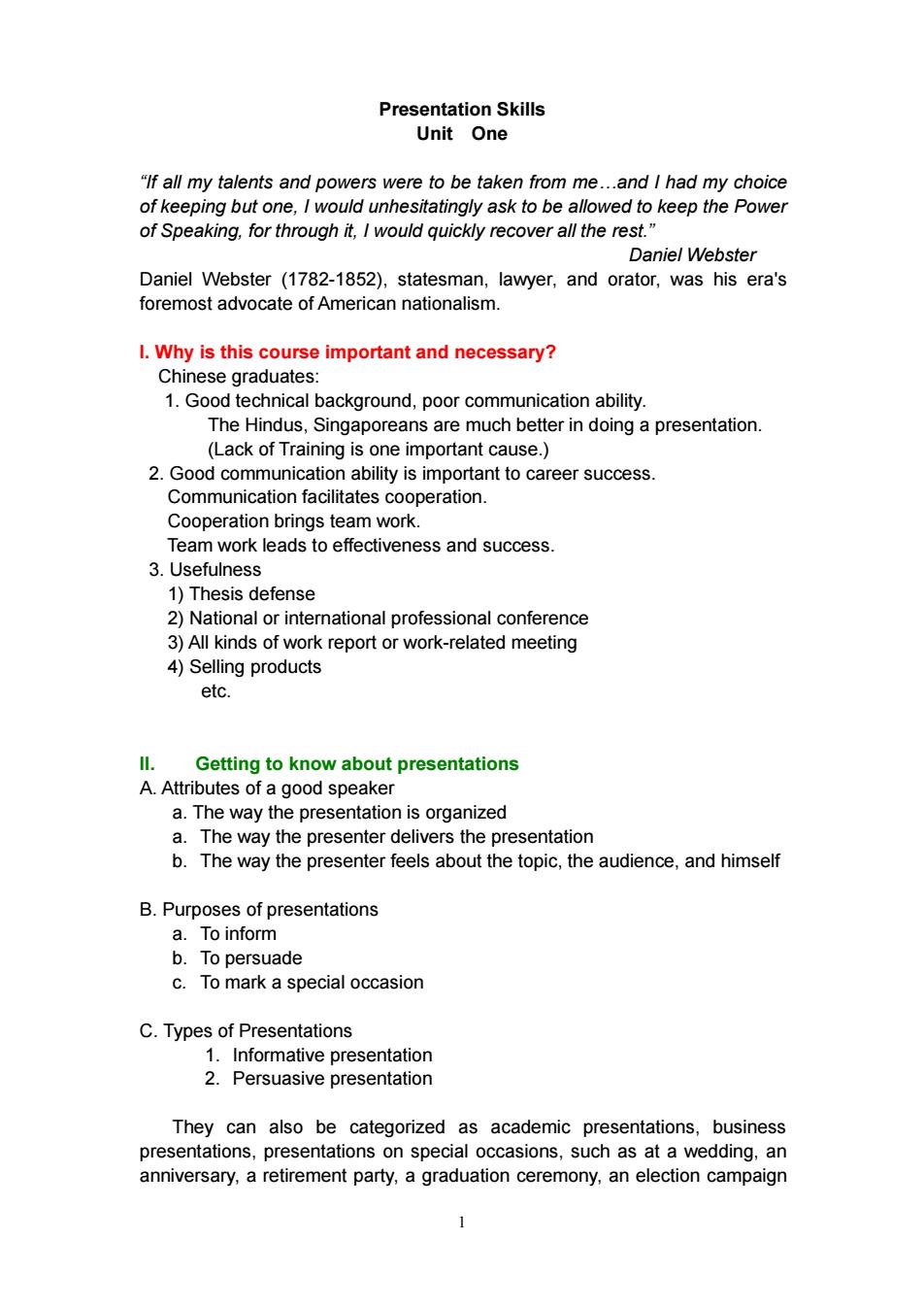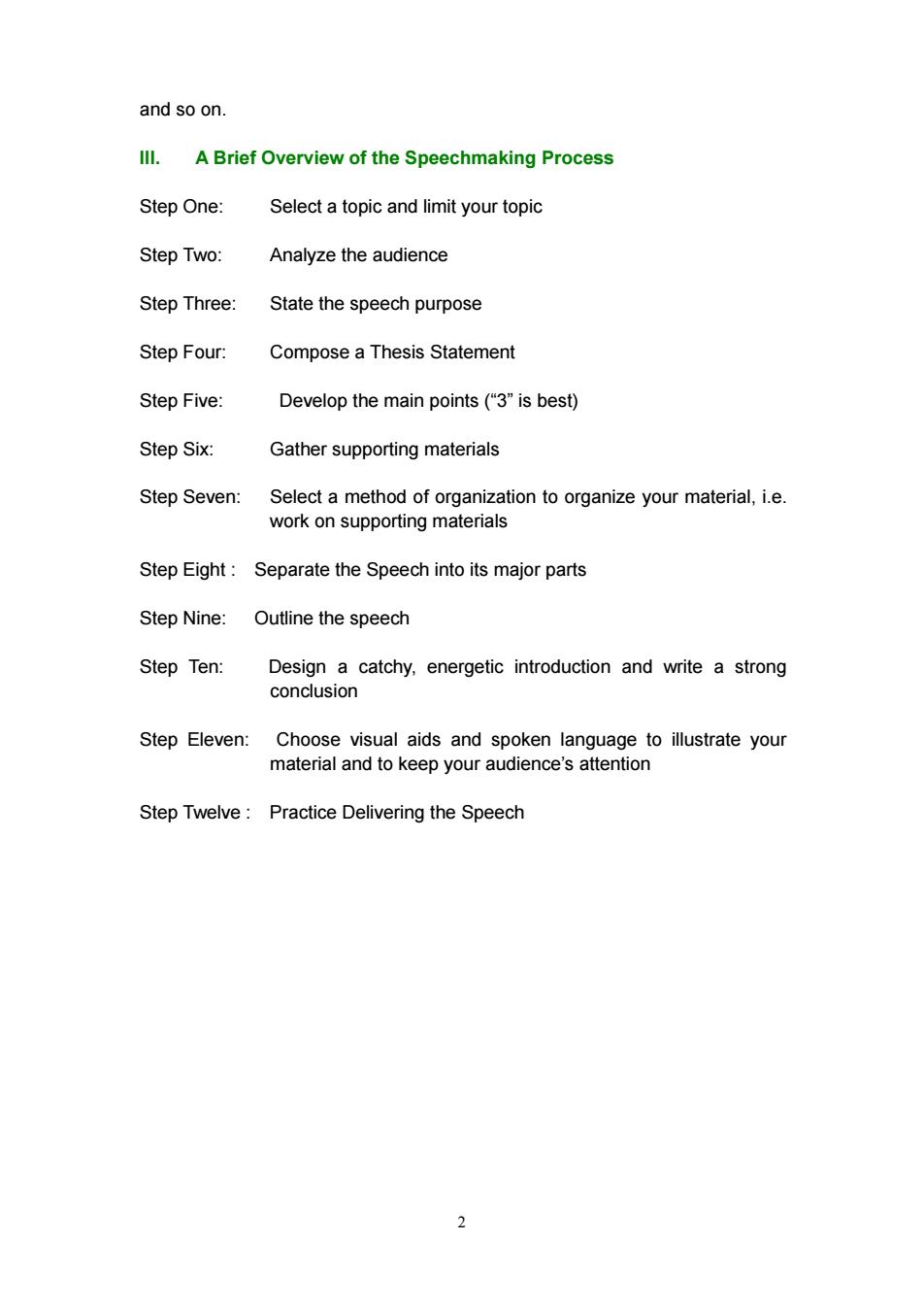
Presentation Skills Unit One "If all my talents and powers were to be taken from me...and I had my choice of keeping but one,I would unhesitatingly ask to be allowed to keep the Power of Speaking,for through it,I would quickly recover all the rest." Daniel Webster Daniel Webster (1782-1852),statesman,lawyer,and orator,was his era's foremost advocate of American nationalism 1.Why is this course important and necessary? Chinese graduates: 1.Good technical background,poor communication ability. The Hindus,Singaporeans are much better in doing a presentation. (Lack of Training is one important cause.) 2.Good communication ability is important to career success. Communication facilitates cooperation. Cooperation brings team work. Team work leads to effectiveness and success. 3.Usefulness 1)Thesis defense 2)National or international professional conference 3)All kinds of work report or work-related meeting 4)Selling products etc. ll.Getting to know about presentations A.Attributes of a good speaker a.The way the presentation is organized a.The way the presenter delivers the presentation b.The way the presenter feels about the topic,the audience,and himself B.Purposes of presentations a.To inform b.To persuade c.To mark a special occasion C.Types of Presentations 1.Informative presentation 2.Persuasive presentation They can also be categorized as academic presentations,business presentations,presentations on special occasions,such as at a wedding,an anniversary,a retirement party,a graduation ceremony,an election campaign 1
1 Presentation Skills Unit One “If all my talents and powers were to be taken from me…and I had my choice of keeping but one, I would unhesitatingly ask to be allowed to keep the Power of Speaking, for through it, I would quickly recover all the rest.” Daniel Webster Daniel Webster (1782-1852), statesman, lawyer, and orator, was his era's foremost advocate of American nationalism. I. Why is this course important and necessary? Chinese graduates: 1. Good technical background, poor communication ability. The Hindus, Singaporeans are much better in doing a presentation. (Lack of Training is one important cause.) 2. Good communication ability is important to career success. Communication facilitates cooperation. Cooperation brings team work. Team work leads to effectiveness and success. 3. Usefulness 1) Thesis defense 2) National or international professional conference 3) All kinds of work report or work-related meeting 4) Selling products etc. II. Getting to know about presentations A. Attributes of a good speaker a. The way the presentation is organized a. The way the presenter delivers the presentation b. The way the presenter feels about the topic, the audience, and himself B. Purposes of presentations a. To inform b. To persuade c. To mark a special occasion C. Types of Presentations 1. Informative presentation 2. Persuasive presentation They can also be categorized as academic presentations, business presentations, presentations on special occasions, such as at a wedding, an anniversary, a retirement party, a graduation ceremony, an election campaign

and so on. Ill.A Brief Overview of the Speechmaking Process Step One: Select a topic and limit your topic Step Two: Analyze the audience Step Three: State the speech purpose Step Four: Compose a Thesis Statement Step Five: Develop the main points("3"is best) Step Six: Gather supporting materials Step Seven:Select a method of organization to organize your material,i.e work on supporting materials Step Eight:Separate the Speech into its major parts Step Nine:Outline the speech Step Ten: Design a catchy,energetic introduction and write a strong conclusion Step Eleven:Choose visual aids and spoken language to illustrate your material and to keep your audience's attention Step Twelve:Practice Delivering the Speech 2
2 and so on. III. A Brief Overview of the Speechmaking Process Step One: Select a topic and limit your topic Step Two: Analyze the audience Step Three: State the speech purpose Step Four: Compose a Thesis Statement Step Five: Develop the main points (“3” is best) Step Six: Gather supporting materials Step Seven: Select a method of organization to organize your material, i.e. work on supporting materials Step Eight : Separate the Speech into its major parts Step Nine: Outline the speech Step Ten: Design a catchy, energetic introduction and write a strong conclusion Step Eleven: Choose visual aids and spoken language to illustrate your material and to keep your audience’s attention Step Twelve : Practice Delivering the Speech